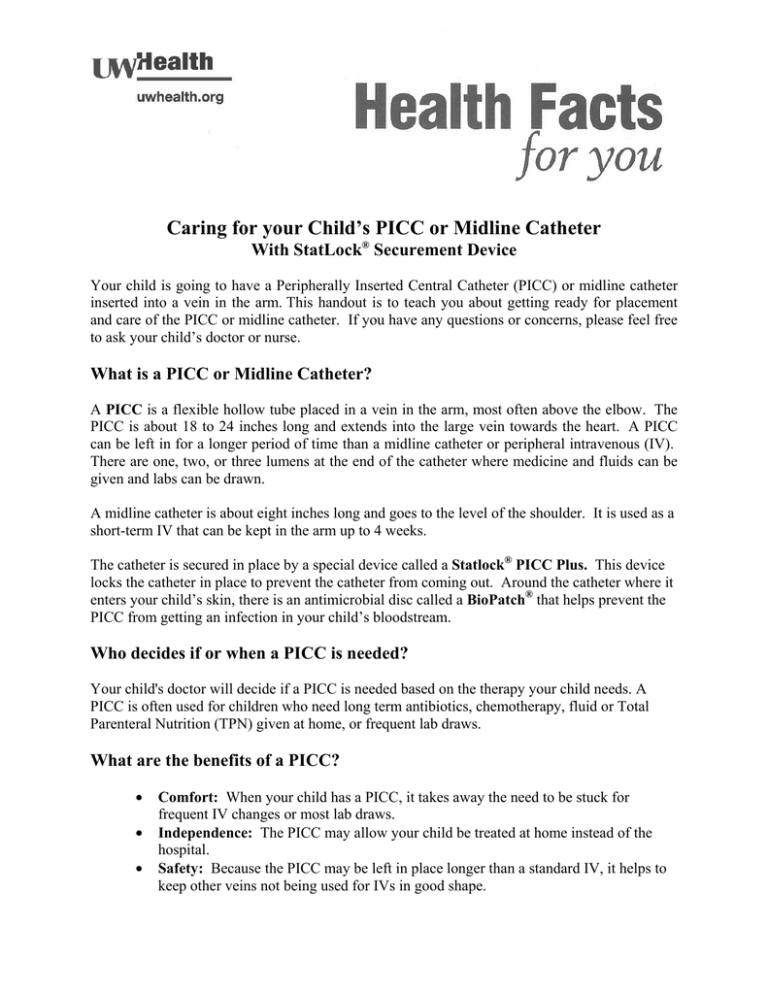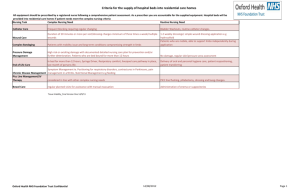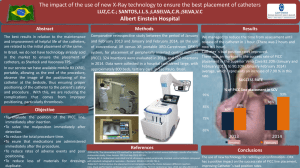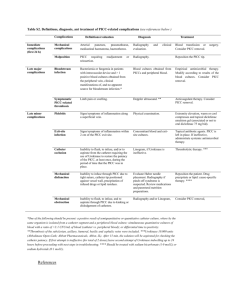
Caring for your Child’s PICC or Midline Catheter
With StatLock® Securement Device
Your child is going to have a Peripherally Inserted Central Catheter (PICC) or midline catheter
inserted into a vein in the arm. This handout is to teach you about getting ready for placement
and care of the PICC or midline catheter. If you have any questions or concerns, please feel free
to ask your child’s doctor or nurse.
What is a PICC or Midline Catheter?
A PICC is a flexible hollow tube placed in a vein in the arm, most often above the elbow. The
PICC is about 18 to 24 inches long and extends into the large vein towards the heart. A PICC
can be left in for a longer period of time than a midline catheter or peripheral intravenous (IV).
There are one, two, or three lumens at the end of the catheter where medicine and fluids can be
given and labs can be drawn.
A midline catheter is about eight inches long and goes to the level of the shoulder. It is used as a
short-term IV that can be kept in the arm up to 4 weeks.
The catheter is secured in place by a special device called a Statlock® PICC Plus. This device
locks the catheter in place to prevent the catheter from coming out. Around the catheter where it
enters your child’s skin, there is an antimicrobial disc called a BioPatch® that helps prevent the
PICC from getting an infection in your child’s bloodstream.
Who decides if or when a PICC is needed?
Your child's doctor will decide if a PICC is needed based on the therapy your child needs. A
PICC is often used for children who need long term antibiotics, chemotherapy, fluid or Total
Parenteral Nutrition (TPN) given at home, or frequent lab draws.
What are the benefits of a PICC?
•
•
•
Comfort: When your child has a PICC, it takes away the need to be stuck for
frequent IV changes or most lab draws.
Independence: The PICC may allow your child be treated at home instead of the
hospital.
Safety: Because the PICC may be left in place longer than a standard IV, it helps to
keep other veins not being used for IVs in good shape.
What is the process?
After the doctor decides that a PICC is the best course of therapy for your child, a child life
specialist comes to your child’s room to talk with you and your child about getting a PICC. This
specialist will also work with you and your child to decide a developmentally appropriate
distraction method. At this time, parents should also think about if they would like to be present
with their child for the procedure. Then, a PICC team nurse comes to your child’s room. This
nurse is specially trained in placing PICC lines. The nurse will look at your child's arm and
decide on one or two veins that will work best.
How can I best comfort my child?
There is some discomfort having a PICC placed. It is like getting an IV placed. Even though the
catheter sits in the vein near the heart, your child should not have any chest pain. Numbing
creams and an oral medicine to help your child relax may be used. Distraction methods such as
listening to music, singing, breathing exercises, and watching TV can also be helpful.
Your child’s health care team may also use a technique called reframing. Reframing is changing
the way a person looks at something. This can change your child’s experience. It helps to talk to
your child using positive statements such as "The PICC you will be getting today will be one
step closer to getting us home”, or "A nurse will come today and put in a different IV so you
won't have to get poked as often. We can use numbing cream and Buzzy Bee®. I know you will
be so brave." Examples of negative talk include, "He never holds still for anything!", or "This
tube will be in forever!” By using reframing it is possible to change your child’s perception of
the experience.
Will my child be asleep?
With the help of numbing and relaxing medicines, and preparation from the child life specialist,
most children do not need sedation. Small children may need to be sedated. The medicines used
for sedation do not actually put your child to sleep, although that’s what it seems like. After the
child life specialist, nurse, and doctor talk with you and your child, the best choice is made based
on the situation. If it is decided that sedation is the best option for your child, the doctor will go
over the risks and benefits and types of sedation.
Can you explain the procedure for placing a PICC?
Just to remind you, every situation will be a little different. Not all children want to use topical
creams and not all children need medicine to help them stay calm. Your child is evaluated and a
personalized plan is created. Below is one example of what might happen:
About 30 minutes before the PICC is placed, your child’s nurse places a numbing cream on the
skin. The nurse may also have your child take an oral medicine called midazolam for relaxation.
Other methods of pain relief and distraction include I Spy books, Buzzy Bee, I Pad games, and
stress balls.
The PICC team sets up while a child life specialist or another member of our staff distracts your
child. The nurse cleans your child's arm with antiseptic soap and puts drapes over the area.
PICC placement is a sterile procedure so it is very important that your child does not touch the
area where the nurse is working. You and your child may be asked to wear masks in the room.
2
After everything is set up, a small needle is used to guide the soft catheter into the vein. A small
camera used to see the vein, is often used. Once the nurse is sure that the PICC is in the vein, the
needle is removed, leaving only the soft catheter behind. A dressing is placed and a x-ray is
taken of your child's arm to ensure that it is in the right spot before use.
When the procedure is over it may be important to use reframing with your child. "You were so
brave! I knew you would do great!"
How Do I Care For and Change the Dressing?
While your child is in the hospital, a nurse changes the dressing every 7 days or more often if the
dressing becomes wet, soiled, or loose. A friend or family member may be taught how to change
the dressing at home as well. At home the dressing will also be changed every 7 days. If the
transparent dressing, StatLock® device, or BioPatch® dressing becomes loose, wet, or
soiled, the whole dressing must be changed.
Supplies: Central Line dressing kits contain these items except where noted.
• Exam gloves (not included in central line kit)
• Sterile gloves
• Mask
• Alcohol swab sticks
• ChloraPrep® skin antiseptic
• Skin prep
• StatLock® PICC Plus (not included in central line kit)
• BioPatch® (may need to be added based on which kit you get from your home
infusion agency)
• Transparent dressing
How to change the sterile dressing
1. Gather all supplies.
2. Wash your hands well with soap and water for 30 seconds. Dry your hands. Apply exam
gloves and mask. If your child is unable to keep his head turned, he has to wear a mask.
3. Take off the transparent dressing using ‘stretch-technique’. Roll the corners of the
dressing furthest from the insertion site and pull outward lifting the transparent dressing
up off the skin. Use alcohol pads or swabs to help loosen the dressing.
4. To unlock the catheter, follow these steps.
a. Stabilize the catheter by placing a gloved finger over the transparent dressing at
insertion site.
b. Stabilize one side of the StatLock®’s doors with the thumb of the same hand
pushing on the catheter.
c. Open the opposite door using the overhang on the bottom of the door (not the
center).
d. Switch hands and repeat.
e. Gently remove the catheter from the StatLock®.
5. Using alcohol, soak an edge of the StatLock® until a corner is lifted. Allow the alcohol
to seep under the pad and dissolve the adhesive. Do not force or pull the pad off, let the
alcohol do the work to dissolve the adhesive.
3
6.
7.
8.
9.
10.
11.
12.
13.
14.
15.
16.
17.
18.
Use an alcohol pad to separate the dressing from the BioPatch® to avoid pulling the
catheter out. Remove the transparent dressing and BioPatch®. Be sure to secure the
catheter.
Look at the insertion site for redness, swelling, or drainage. Check to see if the catheter
has moved out of the skin. If it has slipped out more than an inch call your home care
nurse or medical provider. Never try to slip the catheter back in the vein, because it
may give you an infection or kink your catheter.
Take off your exam gloves and wash and dry your hands. While doing this remember to
never turn your back to your child.
Open sterile supplies, including StatLock® kit and put on sterile gloves.
Remove dried blood or debris with alcohol wipes or swabs.
Activate the ChloraPrep® applicator to release the liquid into the sponge pad. Please note
that your home kits contain 3 swabs. Do not touch the pad/swab. Gently press the
sponge/swab against the skin near the catheter PICC site until you can see the liquid on
the skin. Use a back-and-forth friction rub for 60 seconds to all skin and catheter areas
being covered by the dressing. Take care to clean the catheter and wings on both sides.
While doing this remember to keep at least one glove sterile. Let air dry for at least 30
seconds. Do not blot, wave at, or blow-dry the area.
Apply skin protectant where the StatLock® anchor and transparent dressing will touch
the skin. Allow to dry.
Place the BioPatch® dressing around the catheter site – blue, grid side up; foam side
down on skin. To make it easy to remove and to
best cover the area around the catheter, the
BioPatch® dressing slit should be placed slightly
off center from the catheter at 5 or 7 o’clock
(catheter itself is considered 6 o’clock).
Loosen doors of the StatLock® by opening and closing them once. Make sure the paper
backing is not stuck to back of the StatLock®.
Place catheter wing securement holes over posts of the StatLock® and close plastic doors
one at a time. Do not press on the patient.
Place anchor pad over prepped securement site. Peel away paper liner, one side at a
time, pressing the pad in place.
Apply sterile transparent dressing over site.
Apply dressing change label to indicate when the dressing is to be changed.
4
Example of Correctly Dressed PICC Site
How Do I Flush the Midline or PICC?
Your child’s PICC should be flushed every day and after each use. If you are not going to give
medicines at home you may flush your child’s line with heparin once a day. If your child needs
medicine given at home then you should use the SASH method (Saline, Administer medication,
Saline, Heparin). Your nurse may tell you to flush the PICC more often if needed.
Supplies
• 10 mL Normal Saline Flushes
• Needleless (MicroClave® Clear) connector
• Sharps® container
1. Clean the top of the needleless (MicroClave® Clear) connector with an alcohol wipe using a
“juicing” method for 15 seconds. Allow to dry while holding the needleless connector, and
not allowing anything to touch the top of the connector until attaching the flush syringe. If
anything touches the top of the connector before attaching the flush syringe, stop and repeat
15 second scrub before proceeding to step 2.
2. Connect the flush syringe to the end of the connector. Make sure that the clamp on the line
is open.
3. Push gently and steadily on the plunger using a push-stop-push method,
clamping the catheter after you complete the flushing. Note: The PICC should
flush easily. If you find it is hard to push the fluid in, check to make sure the
clamp is open and that the catheter is not kinked. If it is still hard to push the fluid in, do
not force the plunger. Call your child’s home care nurse or doctor.
4. Remove the syringe and discard it in the sharps container. At home, you may double bag
syringes without needles.
5
How Do I Change the Needleless Connector?
The needleless connector on your child’s PICC is changed using a sterile technique every three
days while in the hospital. At home, the needleless connector can be changed once a week if
your child is not immune compromised. If your PICC is used for blood draws, it needs to be
flushed with 10 ml normal saline after each blood draw using a push-stop-push method. After
flushing, if you can see blood in the needleless connector, remove the connector and replace with
a new one. If you are going home with your line, be sure to flush with saline before and after
your medicine.
Supplies
•
•
•
•
10 mL Normal Saline Flushes
Needleless (MicroClave® Clear) connector
Sharps® container
Gloves
1. Wash your hands and apply gloves. Remove the plastic cover from the syringe. Push the air
out of the syringe.
2. Connect the syringe filled with saline to the end of the needleless connector.
Twist on completely. If the tip of the syringe touches anything other than the
end of the catheter, stop, and replace the syringe.
3. Remove the plastic end from the MicroClave® Clear connector. While keeping the PICC
clamped, remove the old MicroClave® Clear connector and twist on the new one.
4. Unclamp your catheter.
5. Push gently and steadily on the plunger using a push-stop-push method,
clamping the catheter as you complete the flushing. Note: The PICC should
flush easily. If you find it is hard to push the fluid in, check to make sure the
clamp is open and that the catheter is not kinked. If it is still hard to push
the fluid in, do not force the plunger. Call your child’s home care nurse or doctor.
6. Remove the syringe. Discard the syringe in the sharps container. At home,
you may double bag syringes without needles.
6
Things to remember when you have a Midline or PICC
•
•
•
•
•
•
•
•
•
•
•
•
•
Avoid having your child’s blood pressure taken on the arm with the midline or PICC.
Close the clamp when catheter is not in use.
Do not re-use IV line caps.
Call your child’s home care nurse or medical provider if your child has a fever of
100.4º F or 38º C.
Call your child’s home care nurse or medical provider if you notice swelling, redness,
or pain at the catheter insertion site or anywhere up the arm.
Wrap your child’s arm in plastic wrap to cover the line and keep the needleless
connector and exit site from getting wet for showers. Glad® Press and Seal works
well. Be sure to change the dressing or the connector if you feel it got wet in the
shower.
Change the dressing, Biopatch, and StatLock® device any time it gets wet, loose, or
soiled.
The PICC may be used for blood draws.
Midlines are not used for blood draws.
Do not use scissors to remove the dressing. It may help to use an alcohol swab to
loosen the adhesive.
If your child is on a pump, put the tubing under clothing so it does not get caught on
furniture.
If the PICC or Midline breaks, put a belt or tourniquet snugly on your child’s upper
arm near the shoulder and go to the closest emergency room. Your child’s infusion
company may give you an A-clamp.
Problems, though rare, do occur. If you have any questions about your child’s PICC
or Midline catheter, please contact your child’s doctor or home care nurse or medical
provider.
Nurse: ________________________________________________________
Doctor: _____________________________________________________
Phone: _______________________________________________________
Name of Home Care Company: ___________________________________________
Home Care Company Phone Number: ______________________________________
Date Catheter Inserted: __________________________________________________
Vein Used: ____________________________________________________________
Catheter Brand: ________________________________________________________
Catheter Lot Number: ___________________________________________________
Catheter Fr/Gauge: ______________________________________________________
Trimmed Catheter Length: ________________________________________________
Date of Last Dressing Change: _____________________________________________
Tip Location: _________________________________________________________
7
Summary for Home Care
What
If no Medicines infuse
through PICC
If medicines will infuse
through PICC
Dressing change
Every 7 days and anytime the
dressing or BioPatch dressing
becomes wet, loose or soiled
Every 7 days and anytime the
dressing becomes wet, loose
or soiled
Flush
At least every day
Use SASH method with each
medicine.
Saline
Administer medicine
Saline
Heparin
Change needleless
(MicroClave® Clear)
connector
Every 3 days
Every 3 days
Accessing the needleless
MicroClave® Clear connector
Clean the top of the needleless
connector with alcohol wipe
using a “juicing” method for
15 seconds and allow to dry
Clean the top of the needleless
connector with alcohol wipe
using a “juicing” method for
15 seconds and allow to dry
Copyright © 12/2013. University of Wisconsin Hospitals and Clinics Authority. All rights reserved. Produced by
the Department of Nursing HF#7595
8





